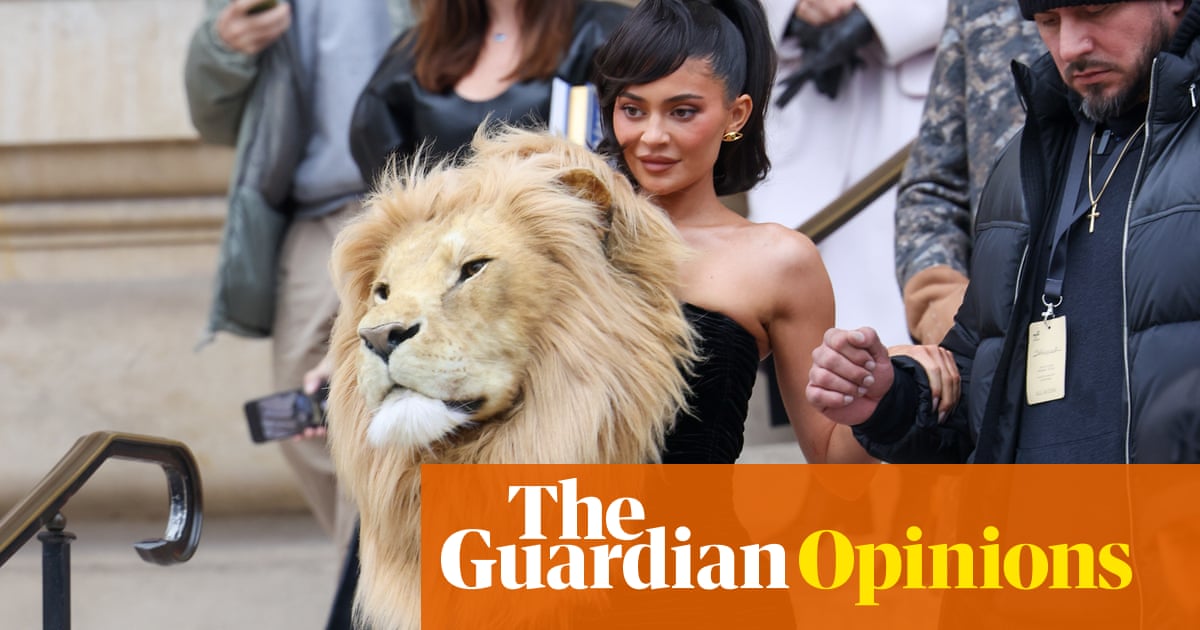
One cold, bright January morning at the beginning of 2023, a chauffeured car pulled up to the marble steps of the Petit Palais in Paris, and Kylie Jenner – lip-gloss mogul and scion of the Kardashian dynasty – emerged. For that morning’s Schiaparelli catwalk show, Jenner was wearing a strapless, black velvet, floor-length gown, with a lifesize lion’s head crafted from foam, silk and fake fur on one shoulder. It was so realistic that many observers took it to be taxidermy. Many animal rights activists thought the look insensitive. The waiting photographers, presented with a moment of pure street theatre, lapped it up. Some of us just wondered whether she had covered herself in glue and run through the London zoo gift shop. Everyone agreed it was in bad taste; everyone also agreed it was, in its own way, sort of brilliant.
Good taste is old hat. Coco Chanel’s famed formula for elegance – before leaving the house, look in the mirror and take one thing off – has no place in a 21st-century media strategy. You can’t break the internet without breaking eggs. On the red carpet, at fancy parties, on the front row – the platforms where the best-dressed once duelled in little black dresses, competing to be the last word in understated perfection – dressing up has become fancy-dress adjacent. The singer Sam Smith wore inflatable black latex – half Leigh Bowery, half Marvel superhero – at this year’s Brit Awards. The actor Jared Leto appeared in full costume as Karl Lagerfeld’s cat, Choupette, at the Met Gala.
Don’t blame clothes, blame the zeitgeist. Outrage is fashionable on all platforms, not just in fashion. In the culture wars era, controversy is the campfire that draws in audiences, who gather round for a shouting match rather than a singalong. Being controversial is more of a vote-winner than being competent, whether you are running for president or best-dressed. The smoothed edges of good taste seem out of step with a world that lurches from crisis to crisis.
The thing is, when the outfits that make the news are ever more outrageous, this has a knock-on impact on how the rest of us dress. Fashion as entertainment has eclipsed the subtle appeal of style. The pleasure of a personal uniform that works for you, of a wardrobe that is quietly aligned with you and your lifestyle, is eclipsed by the magpie appeal of a smörgåsbord of clickbait trends, from angelcore to indie sleaze.
But a year after Jenner’s lion roared at Paris fashion week, there are signs that old-fashioned good taste is making a comeback. Fashion has two new main characters this season: the late Carolyn Bessette Kennedy, the fashion publicist wife of John F Kennedy Jr, and the fashion designer Phoebe Philo, who is making clothes again after a six-year sabbatical. One is American, one British; one long dead and one very much alive. What they share is good taste as a kind of superpower.
Twenty-four years after the plane crash that killed her, along with her husband and sister, CBK is becoming, like Diana, Princess of Wales before her, a “ghost muse” for designers, stylists and influencers. The fanfare around CBK is notable, because there was nothing remotely flashy about her wardrobe of perfect white shirts and simple tailoring. Her wedding dress, a lithe sliver of ivory silk, was a masterpiece of less-is-more glamour. Sunita Kumar Nair, the author of a new book, Carolyn Bessette Kennedy: A Life in Fashion, told the New York Times that her appeal lies in an old-school steadfastness, with a consistency that made her clothes feel like “part of her psyche” rather than a play for attention.
The clue to what gives Phoebe Philo’s new label its point of difference is in the name. It is called, simply, Phoebe Philo. Self-titled brands have been out of fashion recently, replaced by a vogue for the tongue-in-cheek – Vetements, the zeitgeist label of the past decade, was named by its Georgian founders after the French word for clothes – but by putting her own name in her clothes, Philo underscores that what she is selling is her own point of view. Yes, women love the soft but precise architecture of her coats, trousers and handbags, but it’s more than that. They love that Philo implicitly trusts her own taste, and in doing so gives them permission to trust theirs, too.
The notion of good taste has always been problematic. Taste gets tangled up with class, status, knowing the unwritten rules, even with breeding. It doesn’t have to be. Having a good eye and a discerning sense of taste is nothing to do with snobbery, although the two are often lazily conflated. Fashion has been hijacked, recently, by the art of showing off. But really, fashion is about wearing the same sort of things as other people are wearing, and is a way of connecting yourself to the present moment, of plugging yourself into the conversations happening in the world around you. Taste is a colours-to-the-mast statement of your own position; fashion can be about showing that you are watching and listening to other people around you. Taste on its own can be a little flavourless; fashion without taste is a junk food diet. There is a sweet spot where the magic happens. And in 2024, we might find our way back there.
Jess Cartner-Morley is associate editor (fashion) at the Guardian
Do you have an opinion on the issues raised in this article? If you would like to submit a response of up to 300 words by email to be considered for publication in our letters section, please click here.
Bagikan Berita Ini














0 Response to "In 2023 you were no one unless dressed as a cat – but 2024 could see a return to the good taste sweet spot - The Guardian"
Post a Comment